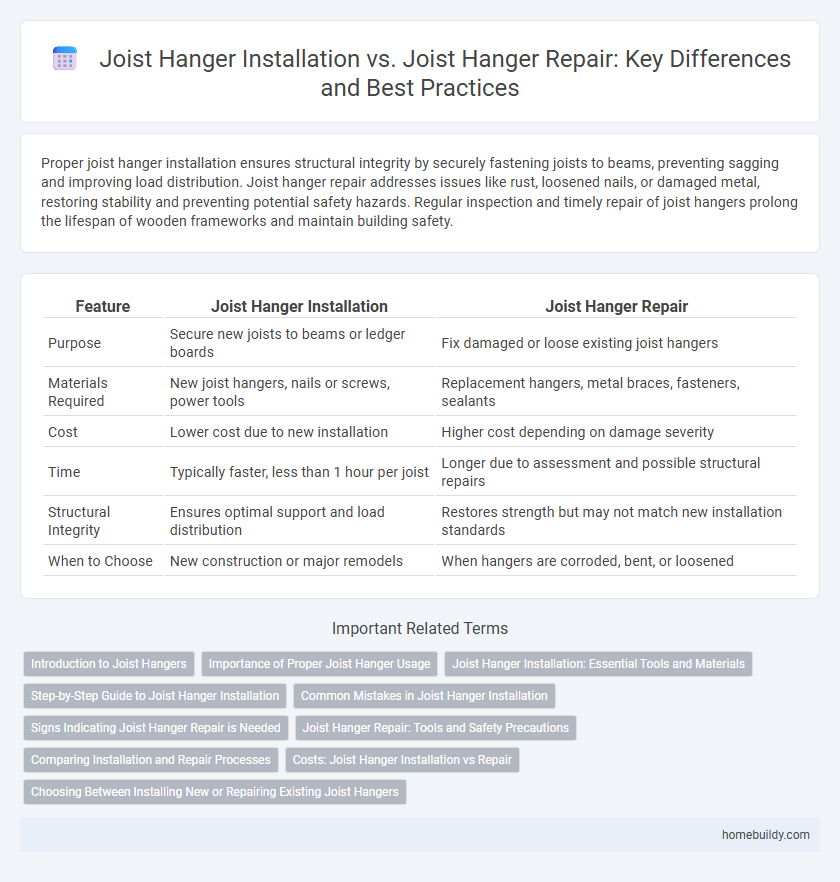Proper joist hanger installation ensures structural integrity by securely fastening joists to beams, preventing sagging and improving load distribution. Joist hanger repair addresses issues like rust, loosened nails, or damaged metal, restoring stability and preventing potential safety hazards. Regular inspection and timely repair of joist hangers prolong the lifespan of wooden frameworks and maintain building safety.
Table of Comparison
| Feature | Joist Hanger Installation | Joist Hanger Repair |
|---|---|---|
| Purpose | Secure new joists to beams or ledger boards | Fix damaged or loose existing joist hangers |
| Materials Required | New joist hangers, nails or screws, power tools | Replacement hangers, metal braces, fasteners, sealants |
| Cost | Lower cost due to new installation | Higher cost depending on damage severity |
| Time | Typically faster, less than 1 hour per joist | Longer due to assessment and possible structural repairs |
| Structural Integrity | Ensures optimal support and load distribution | Restores strength but may not match new installation standards |
| When to Choose | New construction or major remodels | When hangers are corroded, bent, or loosened |
Introduction to Joist Hangers
Joist hangers secure wood joists to beams, ensuring structural stability and preventing sagging or shifting. Proper joist hanger installation involves selecting the correct hanger size, using appropriate nails or screws, and ensuring the hanger sits flush against the beam and joist for optimal load distribution. Repairing joist hangers focuses on replacing damaged or rusted hangers and reinforcing weak connections to restore overall framing integrity.
Importance of Proper Joist Hanger Usage
Proper joist hanger installation ensures optimal load distribution and structural integrity, preventing potential wood rot and metal corrosion that compromise safety. Repairing joist hangers often addresses damage caused by improper installation, but may not fully restore original strength. Consistent use of correctly sized and corrosion-resistant joist hangers is essential for long-term durability and compliance with building codes.
Joist Hanger Installation: Essential Tools and Materials
Joist hanger installation requires essential tools such as a hammer, galvanized nails or structural screws, a measuring tape, a level, and a drill for precise fastening. High-quality metal joist hangers made of galvanized steel ensure durability and resistance to corrosion. Proper installation techniques and accurate placement of joist hangers guarantee structural stability and support for floor or deck framing.
Step-by-Step Guide to Joist Hanger Installation
Proper joist hanger installation involves securing the hanger to the ledger board and joist with manufacturer-recommended nails or screws, ensuring load-bearing alignment and structural integrity. Begin by measuring and marking the joist location, then position the hanger flush with the ledger, driving fasteners through all pre-punched holes to prevent movement and potential failure. Unlike joist hanger repair, which addresses corrosion or damage, installation focuses on precise placement and fastening from the start to enhance deck stability.
Common Mistakes in Joist Hanger Installation
Common mistakes in joist hanger installation include improper alignment, using the wrong fasteners, and inadequate fastening depth, which compromise structural integrity. Failure to set joist hangers flush with the ledger board often leads to misaligned joists and uneven load distribution. Repairing damaged joist hangers typically requires removing or reinforcing the faulty hardware, but correct initial installation prevents costly and labor-intensive repairs.
Signs Indicating Joist Hanger Repair is Needed
Visible rust, corrosion, or bending in joist hangers often signal the need for immediate repair to maintain structural integrity. Loose nails or screws and gaps between the joist and hanger indicate improper installation or wear over time, requiring professional assessment. Sagging or uneven floors above the joist hanger location also serve as critical signs that repair or replacement is necessary to prevent further damage.
Joist Hanger Repair: Tools and Safety Precautions
Joist hanger repair requires specialized tools such as a hammer, galvanized nails or screws, pry bar, and a level to ensure stability and alignment. Safety precautions include wearing protective gloves, safety glasses, and ensuring the work area is clear of debris to prevent accidents. Proper repair extends the lifespan of the structure and maintains load-bearing integrity, emphasizing the importance of precise installation and careful handling during maintenance.
Comparing Installation and Repair Processes
Joist hanger installation involves positioning and securing new metal brackets to support beams, ensuring structural stability and load distribution in construction projects. Repairing joist hangers typically requires assessing existing damage, removing rust or corrosion, and reinforcing or replacing compromised components to restore strength and safety. Installation demands precise alignment for new construction, while repair focuses on maintaining integrity without extensive dismantling.
Costs: Joist Hanger Installation vs Repair
Joist hanger installation typically costs between $5 and $15 per hanger, depending on materials and labor, while repair expenses vary widely based on damage severity, often ranging from $100 to $500 for minor fixes. Installation involves upfront investment but ensures structural integrity and reduces long-term maintenance costs, whereas repairs can become costly if corrosion or structural damage worsens. Proper installation minimizes future repair frequency and overall expenses associated with joist hanger issues.
Choosing Between Installing New or Repairing Existing Joist Hangers
Choosing between installing new joist hangers or repairing existing ones depends on the extent of damage and structural integrity. New joist hanger installation ensures optimal load support and corrosion resistance, especially when upgrading to galvanized or stainless steel models. Repairing existing hangers can be cost-effective for minor damage but may compromise long-term stability if rust or deformation is significant.
Joist hanger installation vs joist hanger repair Infographic

 homebuildy.com
homebuildy.com